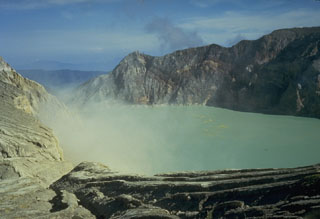Report on Ijen (Indonesia) — 27 May-2 June 2020
Smithsonian Institution / US Geological Survey
Weekly Volcanic Activity Report, 27 May-2 June 2020
Managing Editor: Sally Sennert.
Please cite this report as:
Global Volcanism Program, 2020. Report on Ijen (Indonesia) (Sennert, S, ed.). Weekly Volcanic Activity Report, 27 May-2 June 2020. Smithsonian Institution and US Geological Survey.
Ijen
Indonesia
8.058°S, 114.242°E; summit elev. 2769 m
All times are local (unless otherwise noted)
PVMBG reported that on 29 May a gas explosion at Ijen generated a plume that rose 250-500 m above the surface of the lake. According to news articles two sulfur miners heard the explosion from under the water at 1230, which created 3-m-high waves in the lake; the miners ran but one tripped and fell into the lake. Search efforts were unsuccessful after three hours and, due to weather conditions and an increased amount of gas in the crater area, had to be suspended.
PVMBG noted that patterns of various types of earthquakes did not indicate increased activity during 17 Janury-29 May. The temperature of the lake water fluctuated between 24.5 and 40.3 degrees Celsius. A lot of rain in the past few months increased the volume of the lake, possibly contributing to a disruption in the system, though these seasonal changes were within normal ranges at the volcano. The Alert Level remained at 1 (on a scale of 1-4), and residents and visitors were advised to not approach the crater rim or descend to the crater floor.
Geological Summary. The Ijen volcano complex at the eastern end of Java consists of a group of small stratovolcanoes constructed within the 20-km-wide Ijen (Kendeng) caldera. The north caldera wall forms a prominent arcuate ridge, but elsewhere the rim was buried by post-caldera volcanoes, including Gunung Merapi, which forms the high point of the complex. Immediately west of the Gunung Merapi stratovolcano is the historically active Kawah Ijen crater, which contains a nearly 1-km-wide, turquoise-colored, acid lake. Kawah Ijen is the site of a labor-intensive mining operation in which baskets of sulfur are hand-carried from the crater floor. Many other post-caldera cones and craters are located within the caldera or along its rim. The largest concentration of cones forms an E-W zone across the southern side of the caldera. Coffee plantations cover much of the caldera floor; nearby waterfalls and hot springs are tourist destinations.
Sources: Pusat Vulkanologi dan Mitigasi Bencana Geologi (PVMBG, also known as CVGHM), Inibaru

